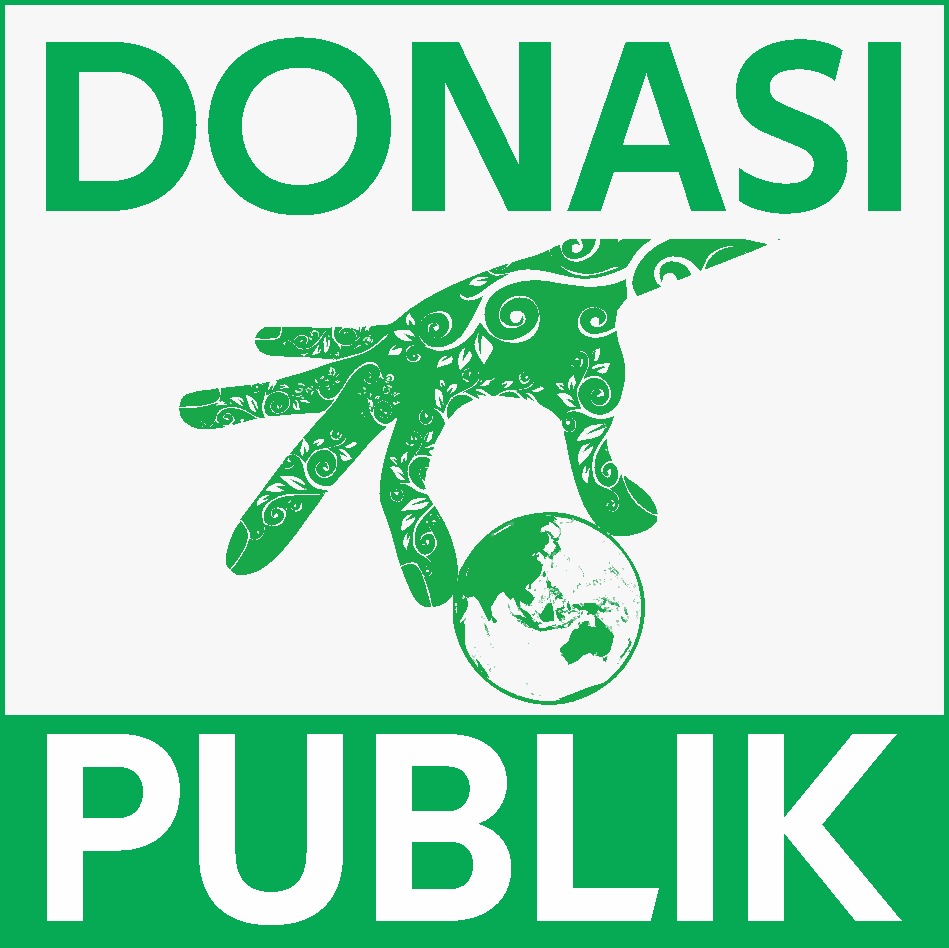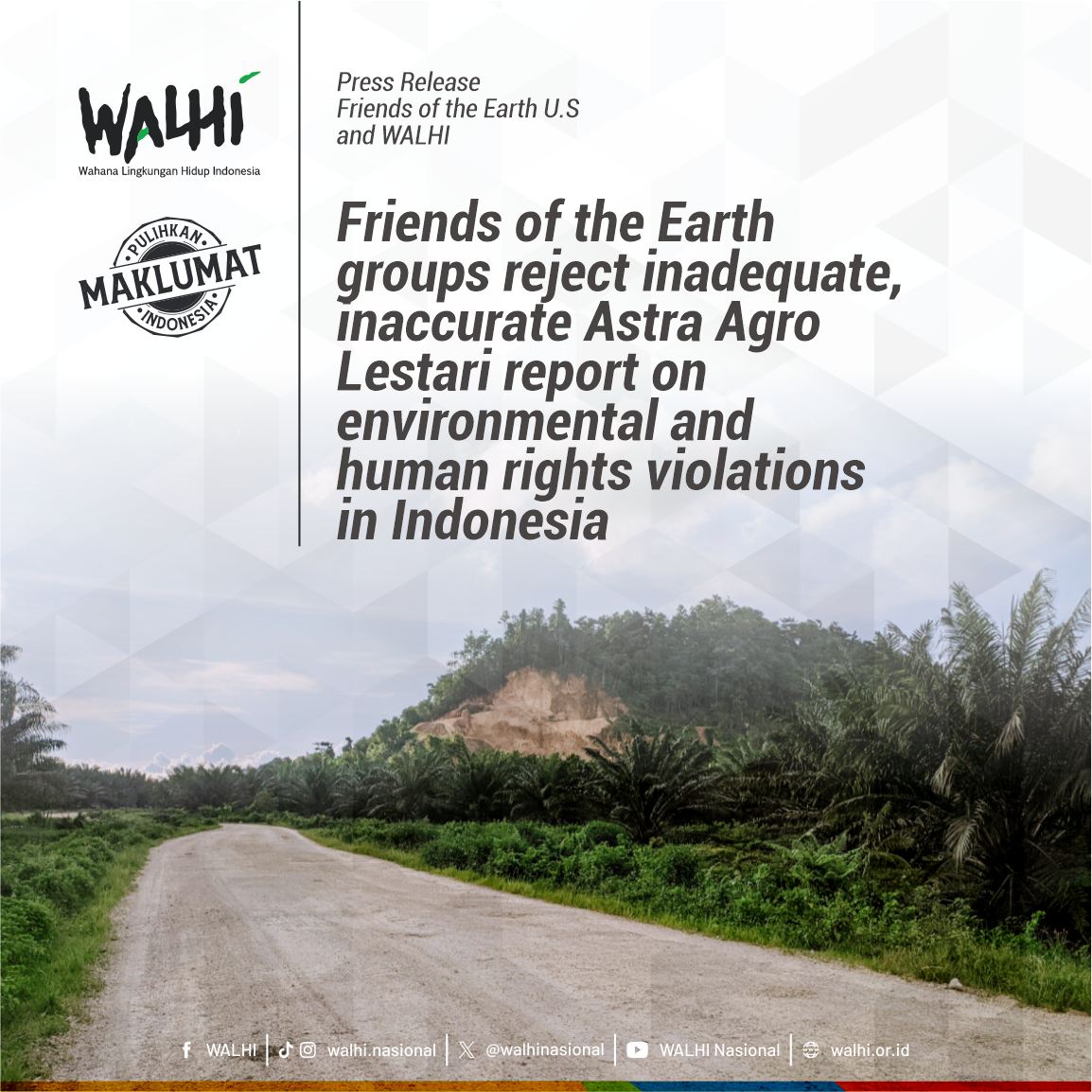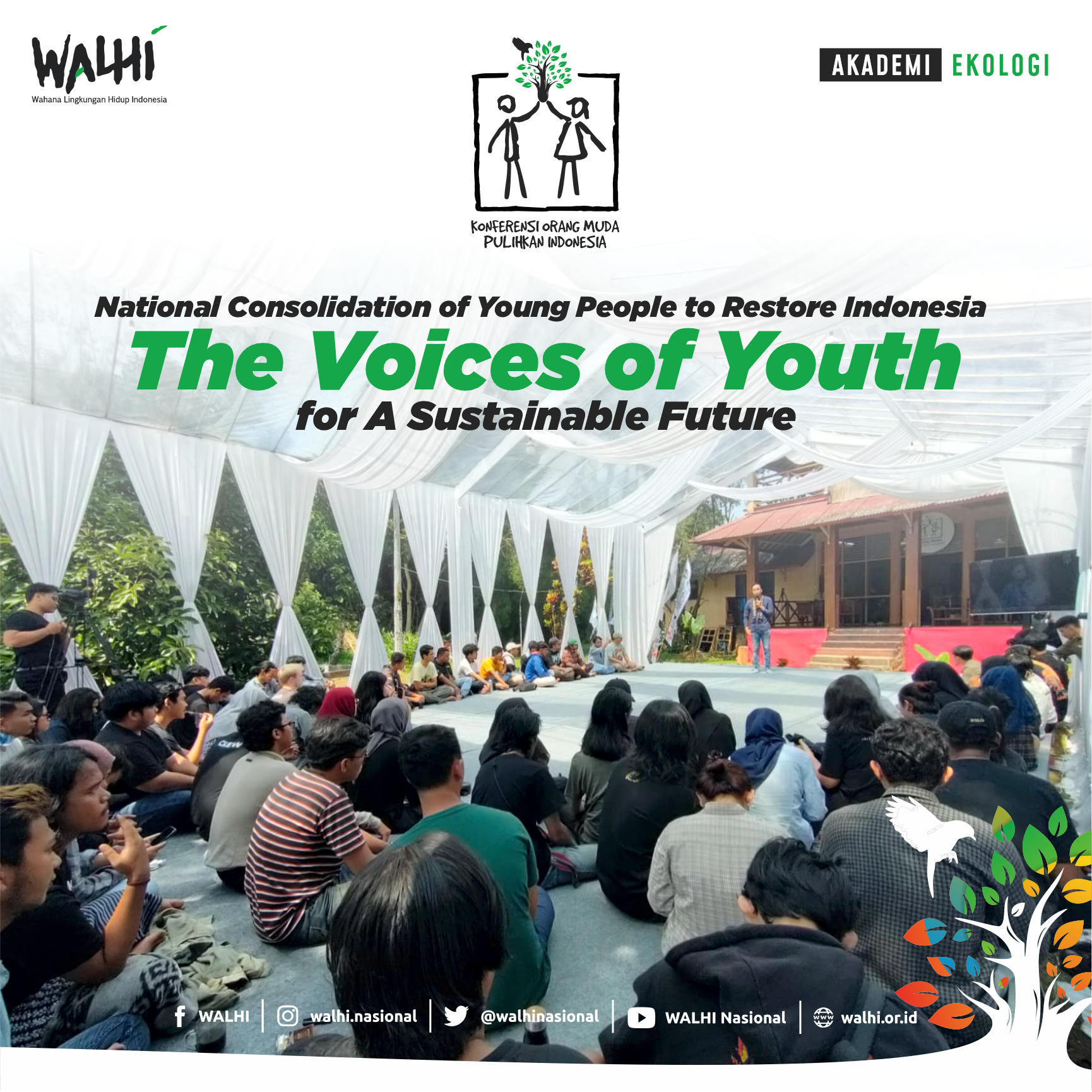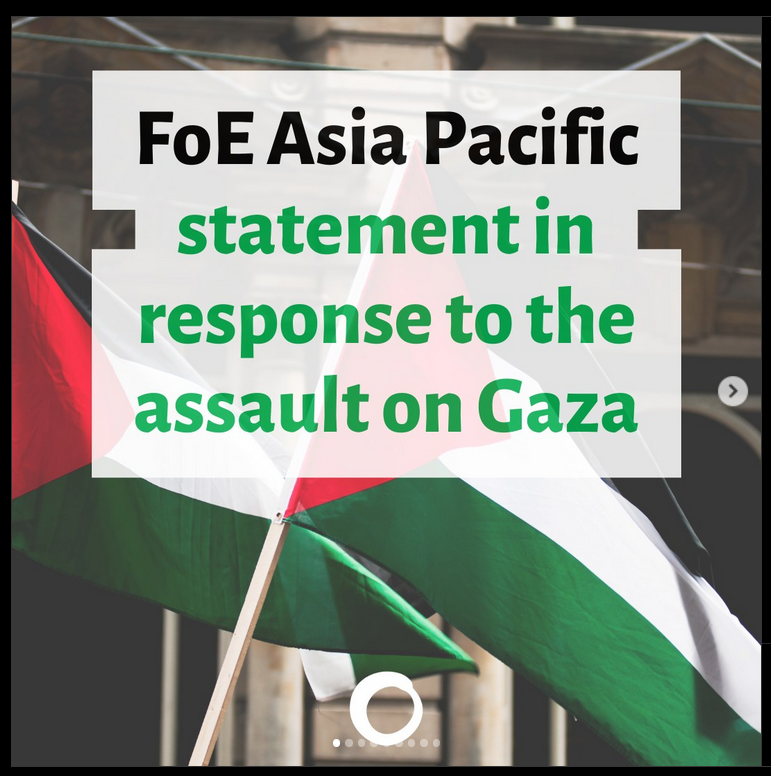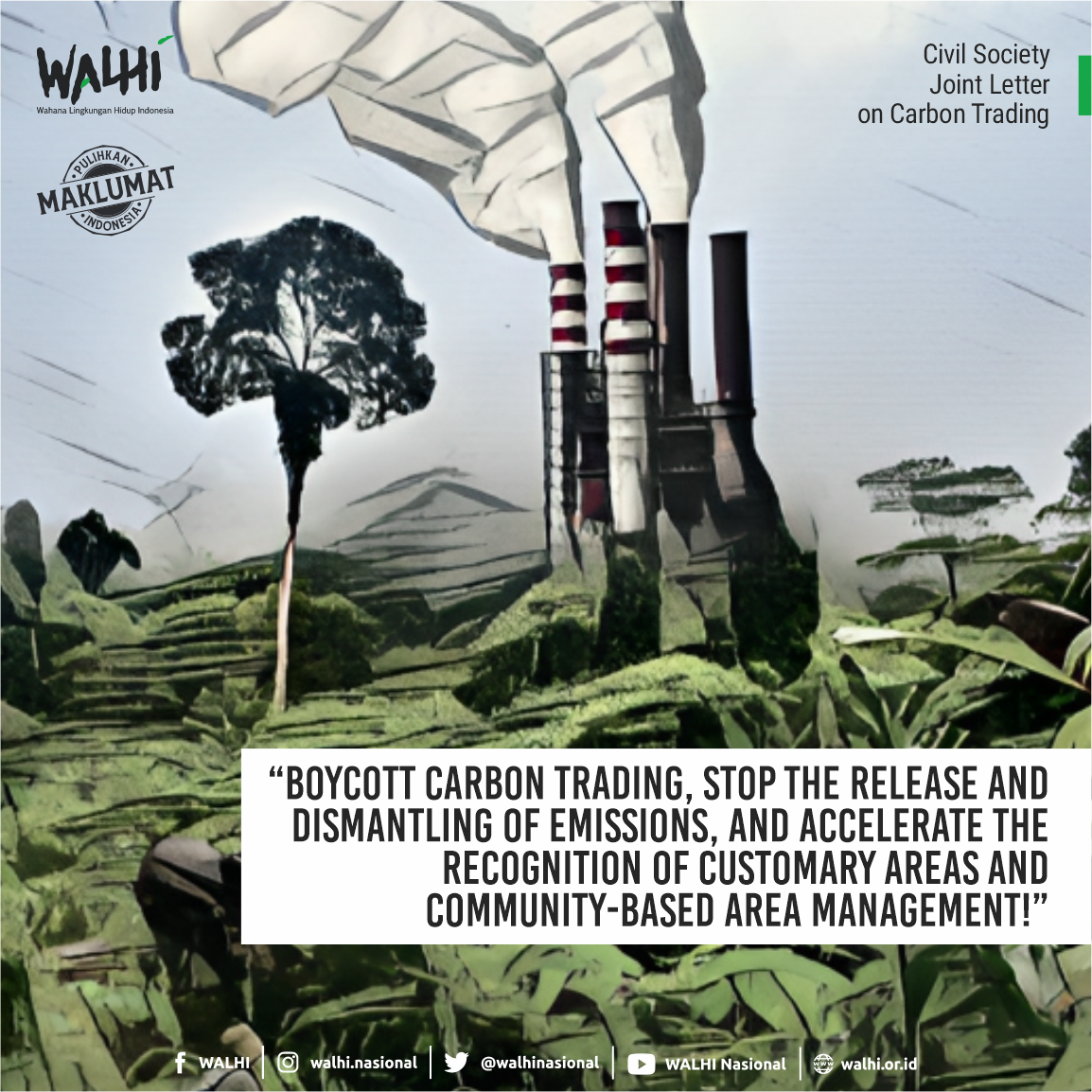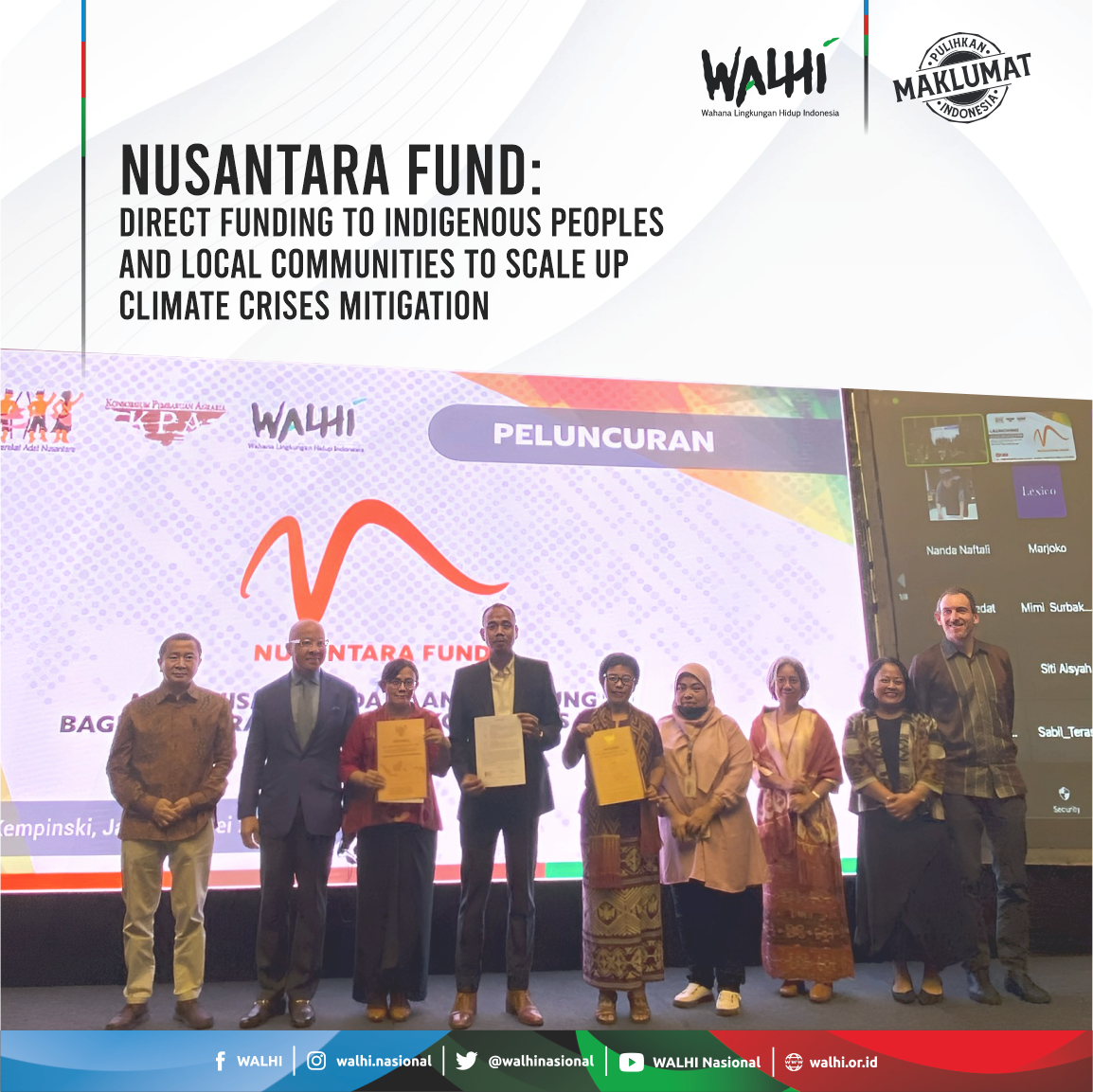
Agus Dwi Hastutik
WALHI/Friends of the Earth Indonesia
The launching of Nusantara Fund, direct funding to IPLCs in Indonesia on May 08, 2023 in Jakarta.
It was on a sunny noon when we were warmly greeted by a group of farmers uphills in Kamojang, West Java, after a motorcycle ride that took us on a twisting, muddy dirt road for about ten minutes uphill on the ridge of Mount Rakutak which is included in the Kamojang Nature Reserve area. Going up, the fresh air from the greenery forest immediately sipped in. As we stepped in the reforested forest by communities, the brisk wind blew in, fresh coffee and local delicacies were served, we were then seated in a circle, on a piece of land covered with a plastic mat, above 1200 above the sea level. Everyone was listening intently to the uplifting stories of these farmers about to unfold.
“This used to be a prone to disaster area, fires happened almost every year.” Said Amir, a farmer from Ibun Village, who is also the chief of the Sauyunan Social Forestry Unit Business (KUPS Sauyunan). “With the social forestry program, we received official permits to manage the land, we no longer have to pay or share yield with the previous managers,” added Amir, explaining that before the land was managed by the villagers, it was managed by Perhutani, a state-own forest agency.
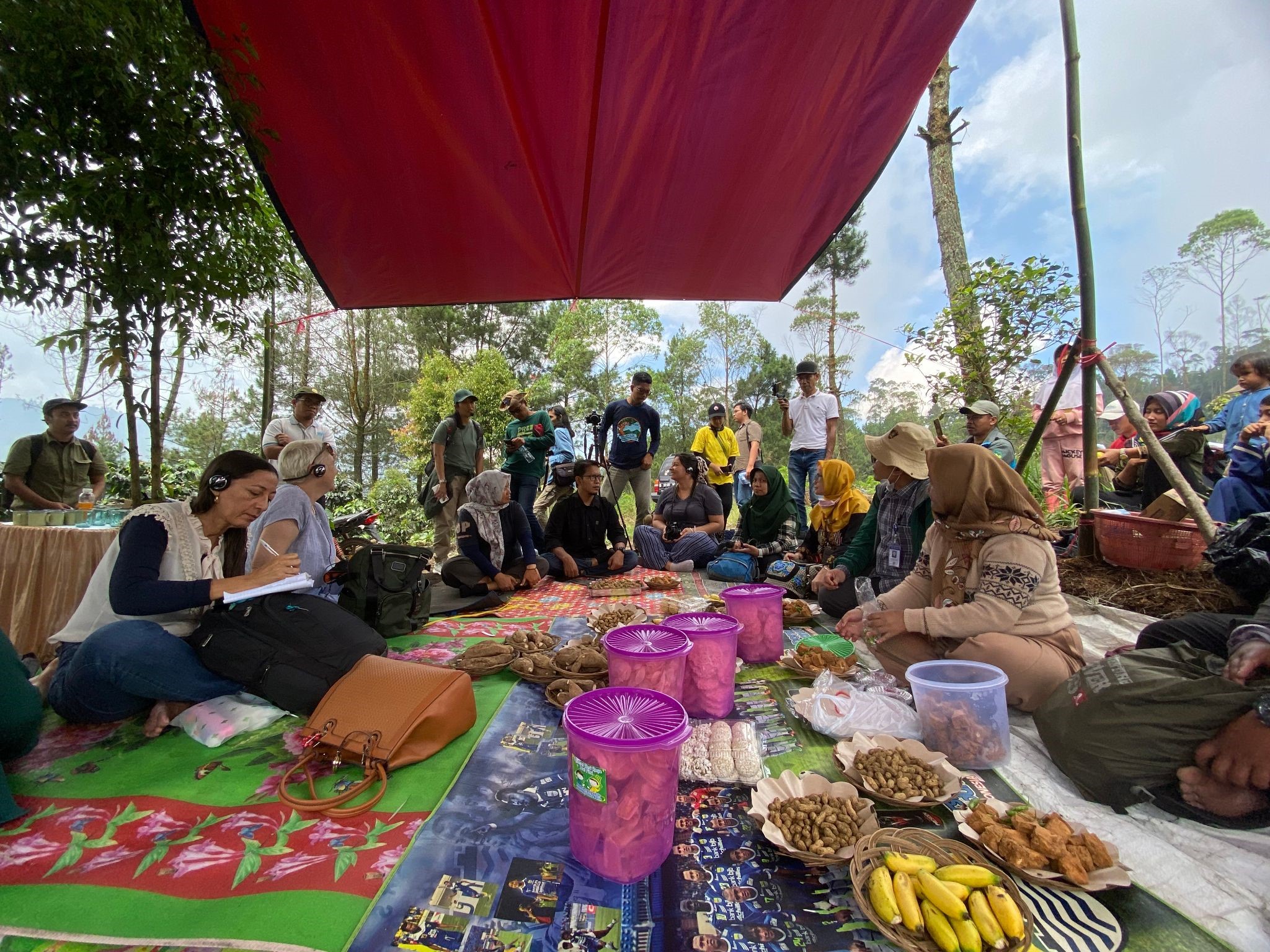
Discussion with farmers from KUPS Sauyunan on their social forestry area in Kamojang, West Java.
Amir and his community in Ibun village are among thousands community members in Kamojang Regency who manage the 1144 hectares of social forestry permits. One family household manages about one hectare of land. The permits were granted by the government, Ministry of Environment and Forestry, in late 2017, covering seven villages, Ibun, Neglasari, Nagrak, Dukuh, Cikawao, Sukarame, and Mandalahaji villages in Rakutak landscape.
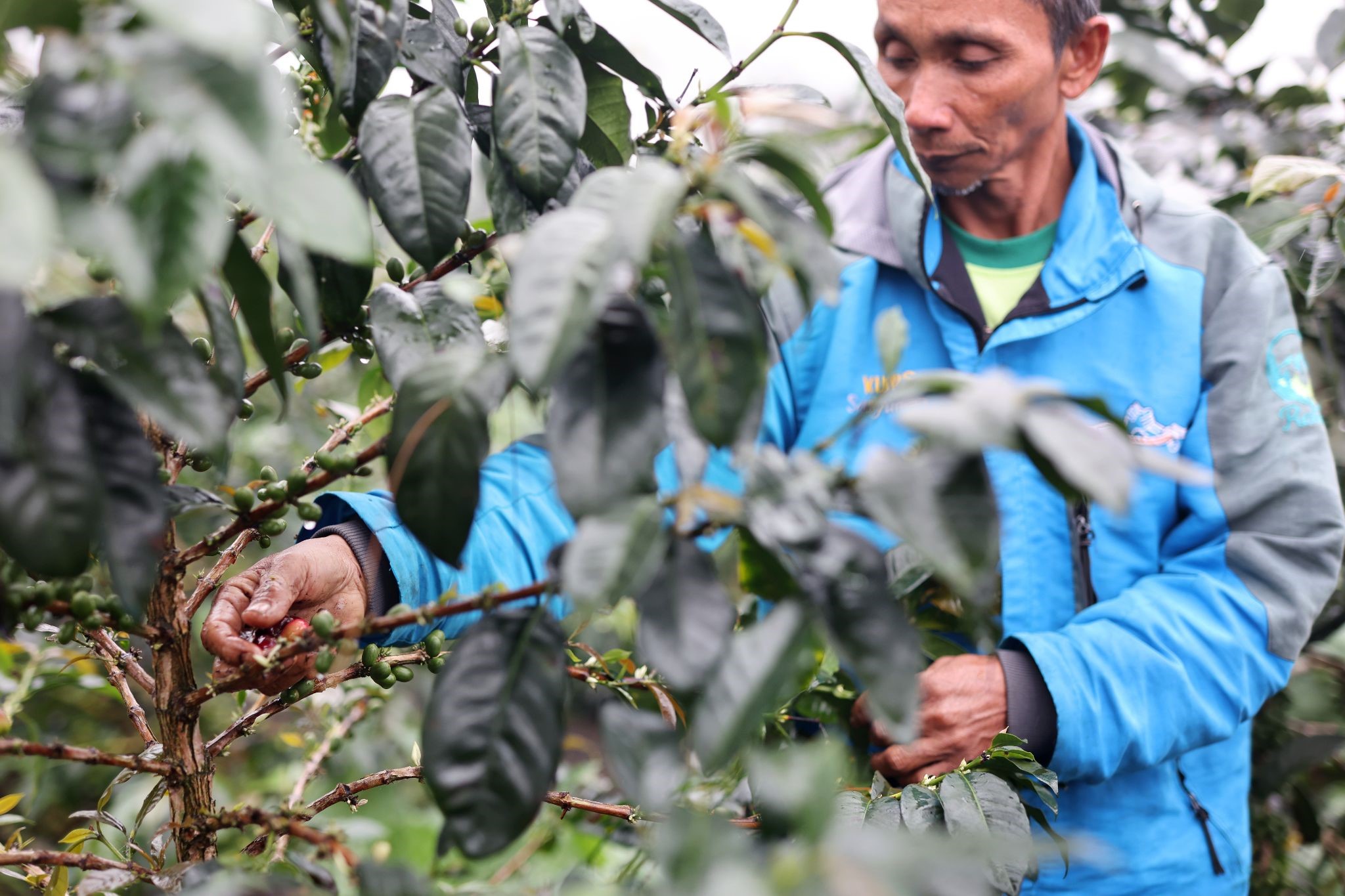
A 65-years old Amir, the head of KUPS Sauyunan.
With the help of assisting organizations, including WALHI and AP2SI (Association of Indonesian Social Forestry Managers), local communities in Ibun are now allowed to manage the areas for 35 years and can be extended for another 35 years.
Communities in Ibun are part of 30 pilot projects that received direct funding of 50 million rupiah from Dana Nusantara (Nusantara Fund). A new initiative by three organizations, WALHI, AMAN and KPA that aims to establish strong support for IPLCs’ initiative to protect and manage their land, territories and resources to increase contribution in reducing emission related to deforestation and forest degradation, increase carbon stocks and improve people’s quality of life.
Communities and organizations from the three initiating organizations are eligible to access this funding. However, Nusantara Funds also allocates part of the funds for external grants to local communities and organizations outside the three institutions.
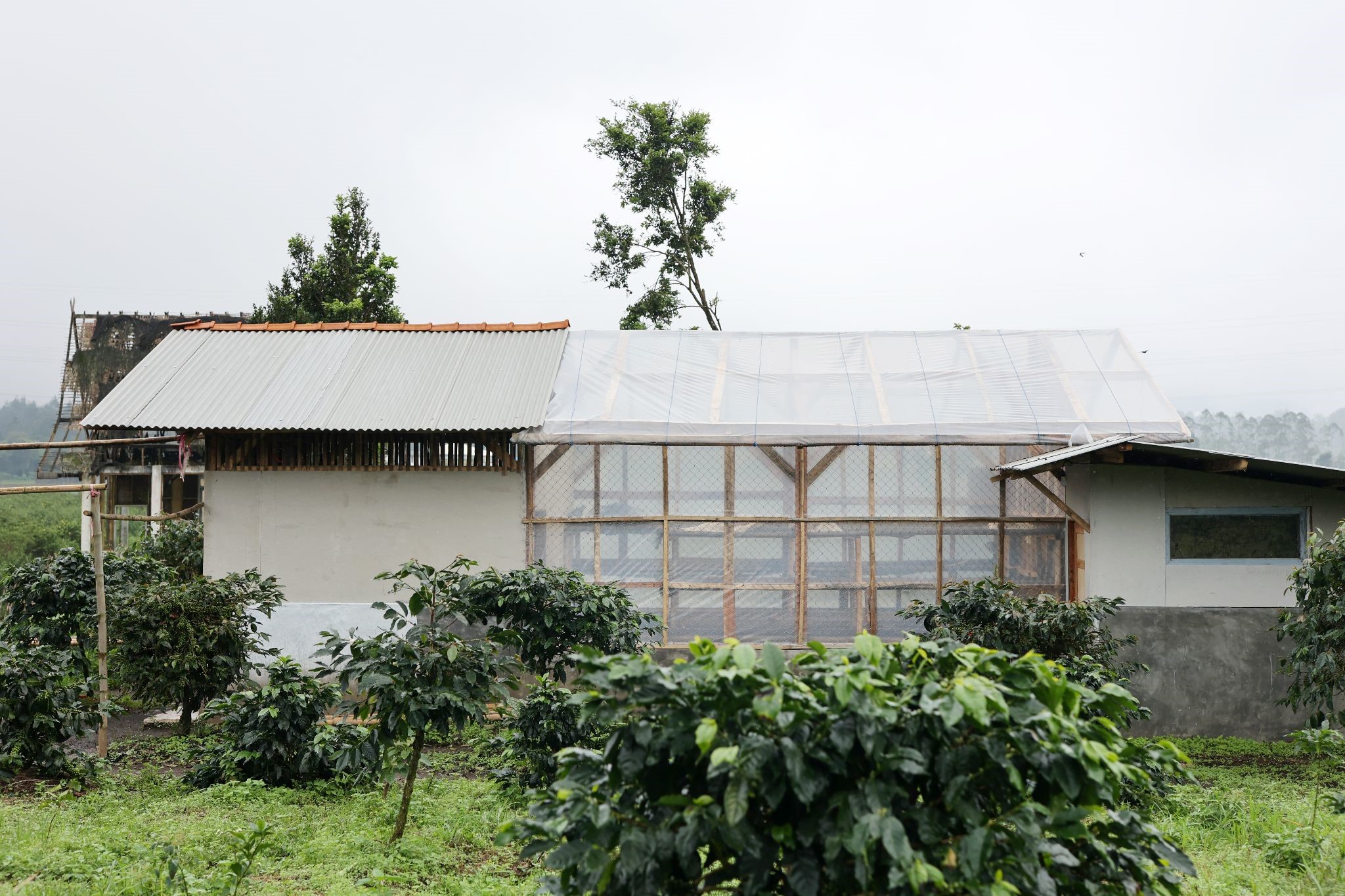
Coffee production house of KUPS Sauyunan, the pilot project fund was used to establish the house for communal use.
“We now have a coffee production house, slowly but surely we are improving the quality and quantity of our production, while doing the preservation of the environment,” said Undang Syahrudin, as he commonly called Dahu, Amir’s deputy explaining that with the help from Nusantara Fund, his communities are able to strive with the infrastructure provided by the fund. While this is not enough, capacity building continues to be a boon in assisting the community in better managing and better producing.
Amir and his community recognize the significance and benefits of managing the land for the preservation of the ecosystem and climate. After the short discussion, we were led to stroll around through little alleyways of what appears to be a coffee plantation at first glance, but upon closer look, other plants such as cabbage and chili are also grown in between. Communities in Ibun village intercrop with other plants as it is also believed to bring fertility to the land. In addition to that, it also helps the ecological recovery and increases biodiversity.
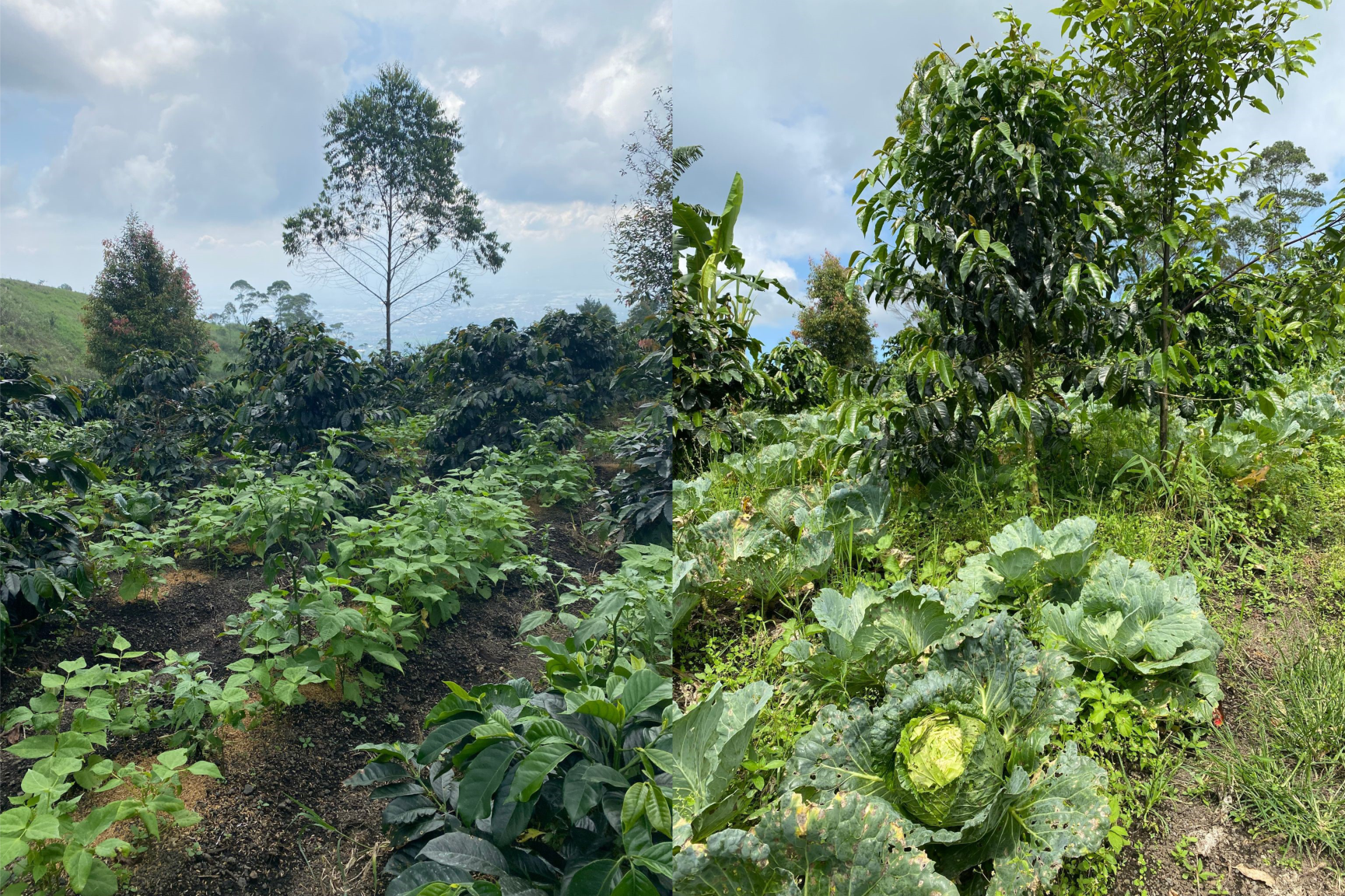
The restored land by the community in Ibun village with an agroforestry model. They intercrop various different plants.
Since the government granted them social forestry permits, they have not only provided farmers the opportunity to manage, but they have also attracted people who left the village to work in the city to return to their communities. Communities in Ibun are hopeful for the future of their livelihoods.
“After years of working to restore land that was once prone to fires, which was full of shrubs and sandy soil, the land is now fertile for cultivating a variety of crops.” Added Dahu.
While efforts to combat the climate crisis continue, indigenous people and communities have been consistently asserted as the best guardians of our planet. Growing research in the past ten years has shown how IPLCs have contributed significantly in stopping deforestation, protecting biodiversity and even improving public health. Yet, less than one percent of global development funds reach them directly. While at the same time they are increasingly threatened due to weak protection and recognition from the government.
In the predicament era of the climate crisis, any ancillary action matters. The Nusantara Fund is set to be supporting system for IPLCs in Indonesia to get recognition and security of rights over land and resources and strengthening of IPLCs governance system, management system and sustainable livelihoods and also to support and empower indigenous and local communities organizations and networks to allow them to continue doing the work they have been doing so effectively with so little support.
This direct fund is actually part of the $1.7 billion pledges of both government and philanthropist organizations which was announced at COP 26 2021 in Glasgow. The goal is to invest in Indigenous peoples and local communities in helping to safeguard the biodiversity of tropical forests that are critical to protecting the planet from climate change, biodiversity loss, and pandemic risk. In the first year since the pledge, 19% (almost $322 million) of $1.7 billion was disbursed, but only 7% of $322 million went directly to indigenous peoples and local communities.
“The people closest to the problem are the same people who can solve it. This is not just a metaphor, it is a necessity,” President of the Ford Foundation Darren Walker said at the launch of Nusantara Fund in Jakarta on May 08 2023. The foundation is among the 22 groups who pledged 1.7 billion USD over five years.
When the pandemic hit the world in 2020 and paralyzed the economy and every sector, Indigenous peoples and local communities were the bastilion that attended to our needs. Growing studies have shown that communities are better organized and they had better results during the pandemic.
Kevin Currey, Ford Foundation’s Natural Resources and Climate Change Program Officer shares from the funder's perspective. “The more money we can get to the local level, the more we can devolve decision making to people on the ground in communities who know it's really needed, the better off will be,” said Kevin, adding that these new direct fundings are going to be very important in providing a new pathway for philanthropist organizations to support communities more directly.
IPLCs, best guardians of the planet
While Indonesia is no exception. Indonesia is wealthy. The country is home to a myriad range of ecosystems that support a diverse range of biodiversity, earning it the title of second most biodiverse country.
In terms of cultural diversity, Indonesia has more than 1300 tribes that have been officially registered by the government, with thousands more who have not.
Indonesia’s wealth in terms of biodiversity and culture should serve as the foundation to build its nation. However, today's situation is pretty alarming. At present, the number of cultural diversity, biodiversity loss of IPLCs are gradually decreasing due to the relentless expansion of extractive industries.
Data from WALHI in 2019 shows that at least 33,000 villages have disappeared to date. The gradual erasure of IPLCs and their knowledge marks not only an irreversible loss for Indonesia, but also for the world.
According to Zenzi Suhadi, executive director of WALHI National, the two crises that the world is currently dealing with, climatic and economic crises, are the result of economic development being prioritized and putting aside the social and environmental concerns.
Indonesia in particular, has experienced environmental crises and contributed greatly to the release of emissions in the last sixty years because the country has deliberately concentrated its economy on extractive industries and failed to recognize the characteristics and long history of the people of the archipelago who used to shape their social, environmental and economic order by adapting to nature.
"This country [Indonesia] has developed its economic base through extractive industries, but has failed to recognize the economy of the archipelago which has existed for thousands of years." Said Zenzi. “The reason we are still able to see distinctive sets of cultures and traditional clothes, such as tenun, as well as the numerous plants that can be utilized, is because IPLCs in the past did not prepare them only for themselves, but for present and future generations to use and preserve.”
IPLCs have long lived in harmony with nature, preserving and utilizing the ecosystem without damaging it. However, they continue to receive little recognition and protection.
“With this Nusantara Fund, we have to put our trusts to those who are on the front lines [IPLCs]. They are not objects of development. They have big potential to address the climate and economic crises.” Said Zenzi, referring to the rich yet irrevocable knowledge of IPLCs, they play vital roles in combating the crises and contributed greatly in protecting the planet.
"We don't have an alternative planet, but we do have an alternative economy," added Zenzi, with the fund from Nusantara Fund, the communities are able to restore their environment and economy. Zenzi expects that the community's production will help build the road for this nation's economy to grow in the right direction. "The right path for this nation is the people's economy, which restores the environment, protects people's rights, and develops the economy."
In line with Zenzi, Secretary General of AMAN–Indonesia’s largest indigenous group, Rukka Sombolinggi stated, "IPLCs is the biggest private sector. The biggest private sector comes from the villages, the communities. When all of the businesses of the villages are incorporated into one, we are the largest private sector.”
Global recognition and potential of scaling up
With the hope of greater global recognition and awareness of IPLCs roles, the potential of scaling up this direct funding is there. These kinds of funds have actually been around for about ten years and have shown very good results. The Nusantara Fund follows the first direct fund that has been given to other countries such as the Mesoamerica Fund in Central America.
David Kaimowitz, Program Officer Chief at The Tenure Facility, is confident that over time the number of these funds will continue to grow and spread in other countries. There is growing donors' proclivity to enhance the possibility to support this kind of model because it actually helps us reach our goals in combating the crisis.
“I think this is a really exciting development for Indonesia, and it's what's happening in Indonesia is also part of a global story about indigenous peoples and local communities responding.” Said David.
“One thing I was thinking of is the amount of money involved here is quite small. Usually one would think that is not newsworthy because other people are pledging billions of dollars, why be interested in $3 million? But precisely what is newsworthy is that these territorial funds are well positioned to accomplish with a few million dollars what governments and big donors have not been able to do even though they throw huge amounts of money at these things.” added David Kaimowitz.
These relatively small funds might not make into a headline, but they make the news and make big differences. In contrast to what we are used to hearing when hundreds of millions of dollars are invested in a certain project, the results are sometimes unclear or even disastrous and merely add to the severity of climate crises. However, with this direct support and the hope that it will continue to increase in the future, it is making a significant difference that, in many respects, can be more successful because communities on the ground know best how to manage and are also becoming more organized.
What WALHI, AMAN, and KPA are doing is just the beginning of bigger things that are bound to happen. We need to get the message out about the significant roles of indigenous peoples and local communities in protecting our planet. They are the best guardians of the planet for no reason.
